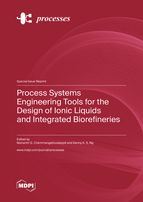Process Systems Engineering Tools for the Design of Ionic Liquids and Integrated Biorefineries
A special issue of Processes (ISSN 2227-9717). This special issue belongs to the section "Environmental and Green Processes".
Deadline for manuscript submissions: closed (15 December 2021) | Viewed by 27141
Special Issue Editors
Interests: process and product design; computer-aided molecular design; integrated biorefineries
Interests: process integration and optimisation; value chain optimisation; net zero; biorefinery and biomass processing; pinch analysis, circular economy
Special Issues, Collections and Topics in MDPI journals
Special Issue Information
Dear Colleagues,
According to Grossmann and Westerberg (2000), process system engineering (PSE) is defined as “the field that is concerned with the improvement of decision-making processes for the creation and operation of the chemical supply chain. It deals with the discovery, design, manufacture and distribution of chemical products in the context of many conflicting goals”. It has, thus, moved away from the traditional concern of understanding and developing systematic procedures for the design, control, and operation of chemical process systems (Sargent, 1999). Grossmann (2004) concluded that product discovery and design, enterprise and supply chain optimization, and global life-cycle assessment (LCA) are likely to emerge as major research challenges within the PSE discipline. Recently, there have been many novel applications in new areas, including ionic liquids and integrated biorefineries. For this Special Issue, we wish to present papers which address process synthesis, design, product design, and development of ionic liquids and integrated biorefineries via PSE tools.
In recent years, ionic liquids have been proposed as a substitute for a number of traditional solvents. Due to their unique properties and the possibility to customize their attributes through careful selection of functional groups, ionic liquids are a highly promising class of chemical compounds. However, the lack of reliable data and relatively high cost of ionic liquids make their selection and application challenging.
Integrated biorefinery is a growing research area which integrates multiple technologies for the conversion of biomass into various products. Being based on the integration of multiple technologies, integrated biorefinery therefore has more flexibility in product generation, self-sustained energy, and a lower overall energy consumption compared with the independent or singular technologies.
This Special Issue on “Process System Engineering for Ionic Liquids and Integrated Biorefineries” aims to curate novel advances in the development and application of PSE tools to address longstanding challenges in the process and product design for ionic liquids and integrated biorefineries. Topics include, but are not limited to:
- Product development of ionic liquids;
- Process systems where ionic liquids can be applied in place of traditional solvents;
- Process synthesis, design, integration, and optimization of integrated biorefineries;
- Scheduling and optimization of integrated biorefineries.
Prof. Dr. Nishanth G. Chemmangattuvalappil
Prof. Dr. Denny K. S. Ng
Guest Editors
Manuscript Submission Information
Manuscripts should be submitted online at www.mdpi.com by registering and logging in to this website. Once you are registered, click here to go to the submission form. Manuscripts can be submitted until the deadline. All submissions that pass pre-check are peer-reviewed. Accepted papers will be published continuously in the journal (as soon as accepted) and will be listed together on the special issue website. Research articles, review articles as well as short communications are invited. For planned papers, a title and short abstract (about 100 words) can be sent to the Editorial Office for announcement on this website.
Submitted manuscripts should not have been published previously, nor be under consideration for publication elsewhere (except conference proceedings papers). All manuscripts are thoroughly refereed through a single-blind peer-review process. A guide for authors and other relevant information for submission of manuscripts is available on the Instructions for Authors page. Processes is an international peer-reviewed open access monthly journal published by MDPI.
Please visit the Instructions for Authors page before submitting a manuscript. The Article Processing Charge (APC) for publication in this open access journal is 2400 CHF (Swiss Francs). Submitted papers should be well formatted and use good English. Authors may use MDPI's English editing service prior to publication or during author revisions.
Keywords
- ionic liquids
- integrated biorefineries
- process systems engineering
- optimization
- scheduling
- process synthesis
- product design
- molecular design







